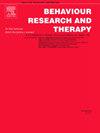Recognition of dynamic angry expressions in socially anxious individuals: An ERP study
IF 4.5
2区 心理学
Q1 PSYCHOLOGY, CLINICAL
引用次数: 0
Abstract
Dynamic facial expressions provide temporal information and ecological validity. In this study, participants with high and low social anxiety were instructed to recognise dynamic expressions of anger at different intensities (15 %, 21 %, 27 %, 33 %, 39 %, 45 %). At the same time, their brain electrical activity was recorded. In terms of behavioural results, the high socially anxious (HSA) group had higher accuracy in recognising dynamic angry facial expressions than the low socially anxious (LSA) group. Compared to the lower anger intensities, participants identified the higher anger intensities with increased accuracy and decreased reaction time (RT). In the electrophysiological results, the HSA group showed increased P3 and LPP amplitudes at intensities of 15 %, 21 %, 27 %, 33 % compared to the LSA group. However, there were no significant differences between the two groups at 39 % and 45 % intensity. The differences between the groups in P1 and P2 amplitudes were not significant. Our findings suggest that when dynamic angry expressions are ambiguous, high socially anxious individuals are more deeply encoded than low socially anxious individuals, which has important implications for the development of interventions.
社交焦虑个体动态愤怒表达的识别:一项ERP研究
动态面部表情提供了时间信息和生态有效性。在这项研究中,高、低社交焦虑的参与者被指示识别不同强度的愤怒动态表达(15%、21%、27%、33%、39%、45%)。与此同时,他们的脑电活动被记录下来。在行为结果方面,高社交焦虑(HSA)组在识别动态愤怒面部表情方面比低社交焦虑(LSA)组有更高的准确性。与较低的愤怒强度相比,参与者识别较高愤怒强度的准确性提高,反应时间(RT)缩短。电生理结果显示,与LSA组相比,HSA组在15%、21%、27%、33%的强度下显示P3和LPP振幅增加。然而,在39%和45%的强度下,两组之间没有显著差异。各组间P1、P2振幅差异无统计学意义。我们的研究结果表明,当动态愤怒表达模棱两可时,高社交焦虑个体比低社交焦虑个体的编码更深,这对干预措施的发展具有重要意义。
本文章由计算机程序翻译,如有差异,请以英文原文为准。
求助全文
约1分钟内获得全文
求助全文
来源期刊

Behaviour Research and Therapy
PSYCHOLOGY, CLINICAL-
CiteScore
7.50
自引率
7.30%
发文量
148
期刊介绍:
The major focus of Behaviour Research and Therapy is an experimental psychopathology approach to understanding emotional and behavioral disorders and their prevention and treatment, using cognitive, behavioral, and psychophysiological (including neural) methods and models. This includes laboratory-based experimental studies with healthy, at risk and subclinical individuals that inform clinical application as well as studies with clinically severe samples. The following types of submissions are encouraged: theoretical reviews of mechanisms that contribute to psychopathology and that offer new treatment targets; tests of novel, mechanistically focused psychological interventions, especially ones that include theory-driven or experimentally-derived predictors, moderators and mediators; and innovations in dissemination and implementation of evidence-based practices into clinical practice in psychology and associated fields, especially those that target underlying mechanisms or focus on novel approaches to treatment delivery. In addition to traditional psychological disorders, the scope of the journal includes behavioural medicine (e.g., chronic pain). The journal will not consider manuscripts dealing primarily with measurement, psychometric analyses, and personality assessment.
 求助内容:
求助内容: 应助结果提醒方式:
应助结果提醒方式:


